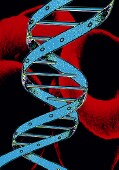- Skip Storing This Everyday Product in the Fridge Door
- Green Tea + B3 Pairing May Boost Brain Health
- Navigating Your Midlife Crisis: Embracing New Possibilities
- City Raccoons Showing Signs of Domestication
- Mapping the Exposome: Science Broadens Focus to Environmental Disease Triggers
- One Week Less on Social Media Linked to Better Mental Health
- Your Brain Changes in Stages as You Age, Study Finds
- Some Suicide Victims Show No Typical Warning Signs, Study Finds
- ByHeart Formula Faces Lawsuits After Babies Sickened With Botulism
- Switch to Vegan Diet Could Cut Your Greenhouse Gas Emissions in Half
Researchers Say They’ve Found New Clues to Autism


A genetic mutation that increases the risk for a certain form of autism and causes specific physical traits and symptoms has been identified by researchers.
The finding may eventually enable doctors to do pre-birth testing for the CHD8 gene mutation in order to identify babies who are at risk for autism, according to the study authors.
“This is a big leap forward in our insight into the causes of autism,” study leader Dr. Raphael Bernier, clinical director of the Autism Center at Seattle Children’s Hospital and associate professor at the University of Washington, said in a hospital news release.
“It’s possible we may be able to look at features in utero and determine a higher risk of autism, possibly even early detection,” he added.
The findings were published July 3 in the journal Cell.
Early detection of autism — a neurodevelopmental disorder — is critical in treating the disorder. Previous research suggests that beginning treatment when children are just a few months old can lessen or even prevent autism symptoms from developing, the researchers said. Autism is characterized by impaired communication and social skills.
“We know that if we can intervene by 3 or 6 months of age instead of later in life, we can help the child learn important social communication skills, like eye contact,” Bernier said in the news release.
Bernier and his colleagues looked at more than 6,000 children with autism and found that 15 had a CHD8 gene mutation. All 15 of those children had similar physical characteristics — such as larger heads and prominent foreheads — and symptoms such as sleep disturbances, constipation and other gastrointestinal problems.
“For years, parents of children with autism have been telling us the gastrointestinal symptoms are real, but science has been slow to respond. Now, we have clear evidence that in a subgroup of individuals with autism, both the autism symptoms and constipation are a result of the CHD8 disruptions,” Bernier said.
“Children with autism are incredibly diverse so we must determine the genetic causes of different subtypes to find effective treatments,” he said.
More information
The U.S. National Library of Medicine has more about autism.
Source: HealthDay
Copyright © 2025 HealthDay. All rights reserved.










